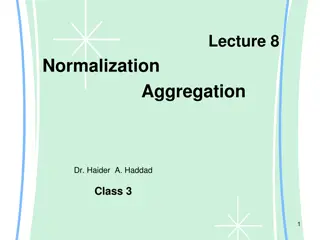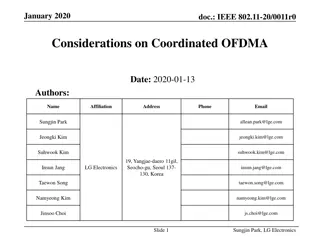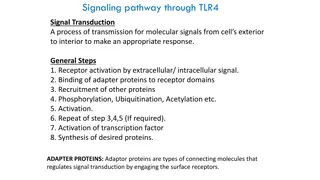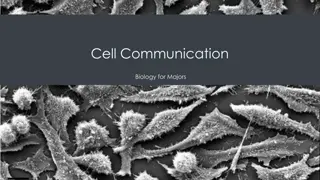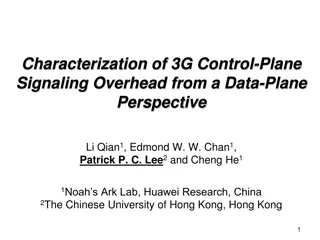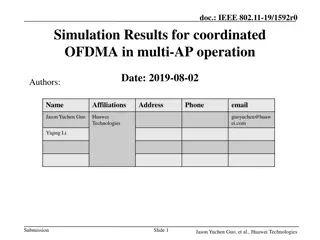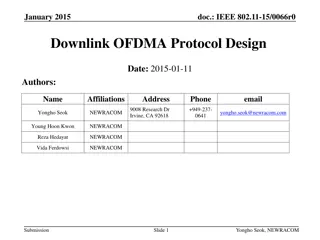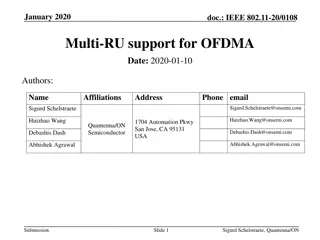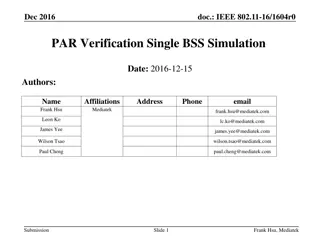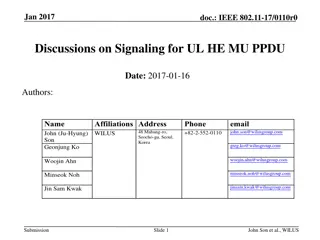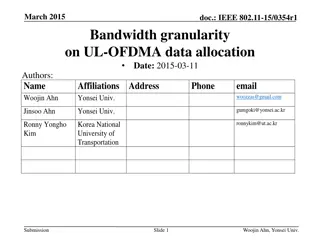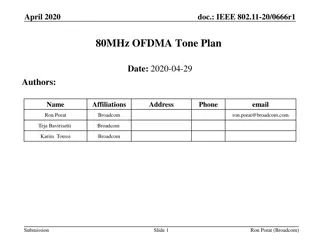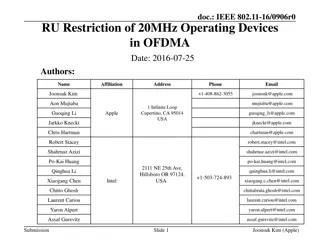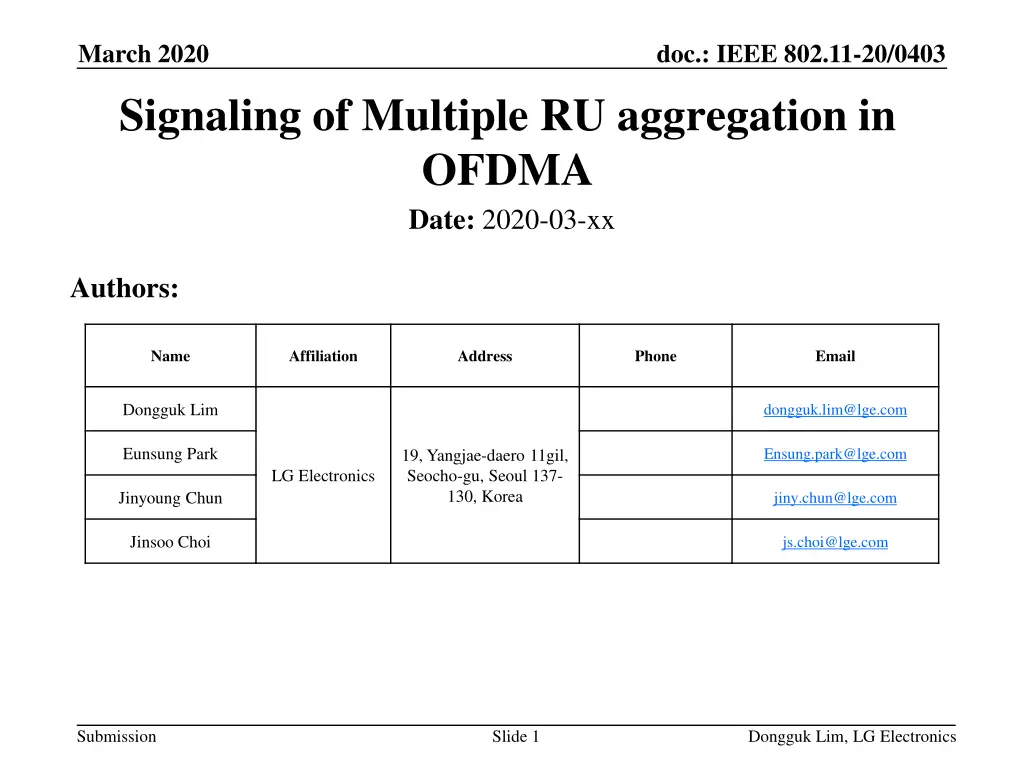
Signaling of Multiple RU Aggregation in OFDMA: IEEE 802.11-20/0403 Study
Explore the approved motions related to multiple RU aggregation in IEEE 802.11-20/0403 standard, including allocations for small-size and large-size RUs in OFDMA scenarios. Consider the possibilities for indicating allocated RU aggregation to STAs. Detailed analysis and configurations presented in this informative document.
Download Presentation

Please find below an Image/Link to download the presentation.
The content on the website is provided AS IS for your information and personal use only. It may not be sold, licensed, or shared on other websites without obtaining consent from the author. If you encounter any issues during the download, it is possible that the publisher has removed the file from their server.
You are allowed to download the files provided on this website for personal or commercial use, subject to the condition that they are used lawfully. All files are the property of their respective owners.
The content on the website is provided AS IS for your information and personal use only. It may not be sold, licensed, or shared on other websites without obtaining consent from the author.
E N D
Presentation Transcript
March 2020 doc.: IEEE 802.11-20/0403 Signaling of Multiple RU aggregation in OFDMA Date: 2020-03-xx Authors: Name Affiliation Address Phone Email Dongguk Lim dongguk.lim@lge.com Eunsung Park Ensung.park@lge.com 19, Yangjae-daero 11gil, Seocho-gu, Seoul 137- 130, Korea LG Electronics Jinyoung Chun jiny.chun@lge.com Jinsoo Choi js.choi@lge.com Submission Slide 1 Dongguk Lim, LG Electronics
March 2020 doc.: IEEE 802.11-20/0403 Introduction 11be TG has approved the following motions related to multiple RU aggregation[1] : Combination of small-size RUs shall not cross 20 MHz channel boundary. The combination that includes RU 106 plus center 26-tone RU case is TBD. Only allowed small-size RU combinations are RU106+RU26 and RU52+RU26. For 20 MHz and 40 MHz PPDU, within 20 MHz boundary, any contiguous RU26 and RU106 can be combined. In 80 MHz OFDMA the following large RU combinations are supported 484 + 242 In 160 MHz OFDMA the following large RU combinations are supported. 484 + 996 In this contribution, we consider the possible three candidates to indicate the allocated multiple RU aggregation to STAs. Submission Slide 2 Dongguk Lim, LG Electronics
March 2020 doc.: IEEE 802.11-20/0403 Combination of small-size RUs (1/2) Based on the passed motions in [1], we can consider the following allocation for combinations of small-size RUs. We assume the followings Bandwidth : 20MHz Number of allocated combination in BW : up to 2 An Allocation subfield is configure per 20MHz. Multiple User transmission (i.e., OFDMA), but, MU-MIMO is not considered. Allocation for RU26+RU52, Index 1 2 3 4 5 6 7 8 9 10 11 1 2 3 4 5 6 7 8 9 26 26 26 26 26 26 26 26 26 26 26 26 26 26 52 52 52 52 52 26 26 26 26 26 26 26 26 26 26 26 26 26 26 26 26 26 52 52 52 26 26 52 106 26 26 52 52 52 52 52 52 26 26 26 26 26 26 26 26 26 26 26 26 52 52 52 26 26 52 106 26 26 52 Submission Slide 3 Dongguk Lim, LG Electronics
March 2020 doc.: IEEE 802.11-20/0403 Combination of small-size RUs (1/2) Allocation for RU26+RU106 index 1 2 3 4 5 6 7 106 106 106 106 106 8 9 1 2 3 4 5 6 7 8 9 26 26 26 26 26 26 26 26 26 26 26 26 26 26 26 26 52 52 52 26 26 52 106 106 106 106 106 106 26 26 26 26 26 26 52 26 26 52 52 52 10 106 We can also consider the allocation of two combinations configured with different small-size RUs. For example, RU26+RU52 and RU26+RU106 can be considered. index 1 2 106 3 4 5 6 7 8 9 1 2 26 26 52 26 26 26 26 52 106 Submission Slide 4 Dongguk Lim, LG Electronics
March 2020 doc.: IEEE 802.11-20/0403 Combination of Large-size RUs We can also consider the following allocation for Combination of Large-size RUs based on 11be SFD[1]. We assume that the multiple user transmission(i.e. OFDMA) but MU-MIMO is not considered. In 80MHz index 1 2 3 484 484 4 1 2 3 4 242 242 242 242 484 484 242 242 242 242 In 160MHz index 1 2 3 4 5 6 7 8 1 484 484 2 3 484 484 4 996 996 996 996 484 484 484 484 For the 240MHz and 320MHz, the above combinations for 160MHz can be used in the continuous 160MHz within this bandwidth. Submission Slide 5 Dongguk Lim, LG Electronics
March 2020 doc.: IEEE 802.11-20/0403 Signaling for combination of multiple RUs As described in previous slides, we can consider the various allocation to support the combination of Multiple RUs. Also, the number of allocation for RU aggregation can be increased because Multiple RU(i.e., M-RU) aggregation is not finalized yet. And, in order to support the various allocation for M-RU aggregation in OFDMA transmission, we need to consider the efficient indication method in 11be. For the signaling of allocated multiple RUs, we can take account of the three options as follows. Option 1 : enhance RU allocation subfield Option 2 : leverage the STA-ID Option 3 : leverage the reserved bits of RU allocation subfield Submission Slide 6 Dongguk Lim, LG Electronics
March 2020 doc.: IEEE 802.11-20/0403 Opt-1: enhanced RU allocation Similar with 11ax, RU allocation subfield in EHT-SIG field can be used for indication of allocated RU. And, in order to accommodate the increased number of allocation due to M-RU aggregation, we can consider the enhanced RU allocation subfield with sizes larger than those defined in 11ax. For example, new RU allocation subfield that contains the allocation for M- RU aggregation can consist of 9 bits. Since it is possible to indicate a maximum of 512 allocation cases, the new RU allocation subfield may sufficiently include the additional allocation due to M-RU aggregation. Herein, an allocation subfield may be designed as following It can be newly composed of 9 bits. Like as 11ax, the allocation subfield consists of 8bit, but an additional 1 bit that is MSB may be used to indicate whether M-RU aggregation or not. It is a simple way to support the increased allocation cases but it requires more bits because of increased bit size for allocation. Submission Slide 7 Dongguk Lim, LG Electronics
March 2020 doc.: IEEE 802.11-20/0403 Opt-2: leverage the STA-ID STA can know which RU is allocated to STA by confirming the STA-ID in the user field which is corresponded to the allocated RU. So, for the indication of the allocation of M-RU aggregation, we can consider that the same STA-ID is set up in the user field which is corresponded to the allocated M-RU. For example, when the following allocation is assumed, STA-ID can be configured such as following. User field 2 and user field 3 for M-RU aggregation (e.g., RU26+ RU52 ) contain the same STA-ID(i.e., STA-ID2). In order to reduce the unnecessary decoding of the user field, it may be considered that the following information is included in the EHT-SIG field. For example, M-RU indication : indication whether allocated RU is M-RU combination or not End of allocated RU : indication whether allocated RU is last allocated RU or not And, since it just changes the value of STA-ID of user field, option 2 can reuse the allocation subfield defined in 11ax. Submission Slide 8 Dongguk Lim, LG Electronics
March 2020 doc.: IEEE 802.11-20/0403 Opt-3 : leverage the reserved bits of RU allocation subfield We can consider only the restricted cases among the various allocation included the M-RU aggregation such as descried in slides 3 to 5. By considering only limited cases for both combinations of small size RUs and large size RUs, we can consider adding up to 31 cases to the RU allocation subfield. In order to support the new allocation, we can use the reserved bit in RU allocation subfield defined in 11ax[2]. For example, the following reserved bits can be considered 116-119 (011101x1x0) 120-127 (01111y2y1y0) 216-223 (11011y2y1y0) 224-255 (111x4x3x2x1x0) Since it only uses the reserved bits in the RU allocation subfield, option 3 can reuse the allocation subfield without defining the new signaling or information for M-RU aggregation. However, if we consider more RU aggregation cases or the MU-MIMO transmission on M-RU aggregation, it may be difficult to support them all due to limited the number of indication entities. Submission Slide 9 Dongguk Lim, LG Electronics
March 2020 doc.: IEEE 802.11-20/0403 Discussion Comparison Opt-1 Opt-2 Opt-3 RU allocation subfield* Expandability Additional information* Additional signaling overhead* New/modified Reusing Reusing Yes Yes Restricted Not Yes Not Yes Yes Not * : compared with RU allocation subfield defined in 11ax Submission Slide 10 Dongguk Lim, LG Electronics
March 2020 doc.: IEEE 802.11-20/0403 Summary We introduced the three options to support the allocation of M-RU combinations. Option 1 : enhance RU allocation subfield In order to support the various allocation cases, the allocation subfield consists of more bits than 11ax. Option 2 : leverage the STA-ID It use the same STA-ID in user field corresponding allocated M-RU Option 3 : leverage the reserved bits of RU allocation subfield It use the reserved bits in RU allocation subfield defined in 11ax. Submission Slide 11 Dongguk Lim, LG Electronics
March 2020 doc.: IEEE 802.11-20/0403 SP1 Which option do you prefer to indicate the allocated Multiple RU aggregation in OFDMA transmission? A: opt-1 B: opt-2 C: opt-3 A/B/C Submission Slide 12 Dongguk Lim, LG Electronics
March 2020 doc.: IEEE 802.11-20/0403 Reference [1] IEEE 802.11-19/1262r7, Specification Framework for TGbe [2] IEEE P802.11ax /D6.0, November 2019 Submission Slide 13 Dongguk Lim, LG Electronics

